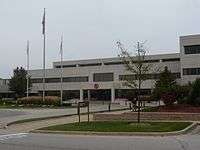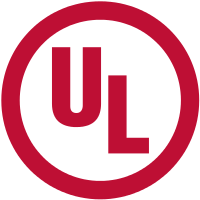UL (safety organization)
|
The UL Certification Mark | |
| Private, LLC | |
| Predecessor | Underwriters Laboratories |
| Founded | 1894 |
| Founder | William Henry Merrill |
Area served | 104 countries |
Key people | Keith Williams (President and CEO) |
Number of employees | 12,000 (2013) |
| Website |
www |
UL is an American safety consulting and certification company headquartered in Northbrook, Illinois. It maintains offices in 46 countries. Established in 1894 as the Underwriters' Electrical Bureau (a bureau of the National Board of Fire Underwriters),[1] it was known throughout the 20th century as Underwriters Laboratories and participated in the safety analysis of many of that century's new technologies, most notably the public adoption of electricity and the drafting of safety standards for electrical devices and components.
UL provides safety-related certification, validation, testing, inspection, auditing, advising and training services to a wide range of clients, including manufacturers, retailers, policymakers, regulators, service companies, and consumers.
UL is one of several companies approved to perform safety testing by the US federal agency Occupational Safety and Health Administration (OSHA). OSHA maintains a list of approved testing laboratories, which are known as Nationally Recognized Testing Laboratories.
History

Underwriters Laboratories Inc. was founded in 1894 by William Henry Merrill. Early in his career as an electrical engineer in Boston, a 25-year-old Merrill was sent to investigate the World Fair’s Palace of Electricity. Upon seeing a growing potential in his field, Merrill stayed in Chicago to found Underwriters Laboratories.
Merrill soon went to work developing standards, launching tests, designing equipment and uncovering hazards. Aside from his work at UL, Merrill served as the National Fire Protection Association’s secretary-treasurer (1903–1909) and president (1910–1912) and was an active member of the Chicago Board and Union Committee. In 1916, Merrill became UL’s first president.
UL published its first standard, “Tin Clad Fire Doors”, in 1903. The following year, the UL Mark made its debut with the labeling of a fire extinguisher. In 1905, UL established a Label Service for certain product categories that require more frequent inspections. UL inspectors conducted the first factory inspections on labeled products at manufacturers’ facilities—a practice that remains a hallmark of UL’s testing and certification program.
UL has expanded into an organization with 64 Laboratories, testing and certification facilities serving customers in 104 countries.[2] It has also evolved from its roots in electrical and fire safety to address broader safety issues, such as hazardous substances, water quality, food safety, performance testing, safety and compliance education and environmental sustainability.[3]
In 2012, UL transformed from a non-profit company into a for-profit corporation.[4][5]
UL Standards
Sustainability Standards
- UL 106, Standard for Sustainability for Luminaires (under development)
- UL 110, Standard for Sustainability for Mobile Phones
Standards for Electrical and Electronic Products
- UL 153, Portable Electric Lamps
- UL 197, Commercial Electrical Cooking Appliances
- UL 796, Printed-Wiring Boards
- UL 1026, Electric Household Cooking and Food Serving Appliances
- UL 1492, Audio/Video Products and Accessories
- UL 1598, Luminaires
- UL 1642, Lithium Batteries
- UL 1995, Heating and Cooling Equipment
- UL 6500, Audio/Video and Musical Instrument Apparatuses for Household, Commercial and Similar General Uses
- UL 60065, Audio, Video and Similar Electronic Apparatuses: Safety Requirements
- UL 60335-1, Household and Similar Electrical Appliances, Part 1: General Requirements
- UL 60335-2-24, Household and Similar Electrical Appliances, Part 2: Particular Requirements for Motor Compressors
- UL 60335-2-3, Household and Similar Electrical Appliances, Part 2: Particular Requirements for Electric Irons
- UL 60335-2-34, Household and Similar Electrical Appliances, Part 2: Particular Requirements for Motor Compressors
- UL 60335-2-8, Household and Similar Electrical Appliances, Part 2: Particular Requirements for Shavers, Hair Clippers and Similar Appliances
- UL 60950, Information Technology Equipment
- UL 60950-1, Information Technology Equipment - Safety, Part 1: General Requirements
- UL 60950-21, Information Technology Equipment - Safety, Part 21: Remote Power Feeding
- UL 60950-22, Information Technology Equipment - Safety, Part 22: Equipment to be Installed Outdoors
- UL 60950-23, Information Technology Equipment - Safety, Part 23: Large Data Storage Equipment
Life Safety Standards
- UL 217, Single- and Multiple- Station Smoke Alarms
- UL 268, Smoke Detectors for Fire Protective Signaling Systems
- UL 268A, Smoke Detectors for Duct Application
- UL 1626, Residential Sprinklers for Fire Protection Service
- UL 1971, Signaling Devices for the Hearing Impaired
Standards for Building Products
- UL 10A, Tin-Clad Fire Doors
- UL 20, General-Use Snap Switches
- UL 486E, Equipment Wiring Terminals for Use with Aluminum and/or Copper Conductors
- UL 1256, Fire Test of Roof/Deck Constructions
Standards for Industrial Control Equipment
- UL 508, Industrial Control Equipment
- UL 508A, Industrial Control Panels
- UL 508C, Power Conversion Equipment
Standards for Plastic Materials
- UL 94, Tests for Flammability of Plastic Materials for Parts in Devices and Appliances
- UL 746A, Polymeric Materials: Short-Term Property Evaluations
- UL 746B, Polymeric Materials: Long-Term Property Evaluations
- UL 746C, Polymeric Materials: Use in Electrical Equipment Evaluations
- UL 746D, Polymeric Materials: Fabricated Parts
- UL 746E, Polymeric Materials: Industrial Laminates, Filament Wound Tubing, Vulcanized Fiber and Materials Used in Printed-Wiring Boards
- UL 746F, Polymeric Materials: -– Flexible Dielectric Film Materials for Use in Printed-Wiring Boards and Flexible Materials Interconnect Constructions
Standards for Wire and Cable
- UL 62, Flexible Cords and Cables
- UL 758, Appliance Wiring Material
- UL 817, Cord Sets and Power Supply Cords
- UL 2556, Wire and Cable Test Methods
Standards for Canada developed by ULC Standards, a member of the UL family of companies
- CAN/ULC-S101-07, Standard Methods for Fire Endurance Tests of Building Construction and Materials
- CAN/ULC-S102-10, Standard Methods of Test for Surface-Burning Characteristics of Building Materials and Assemblies
- CAN/ULC-S102.2-10, Standard Methods of Test for Surface-Burning Characteristics of Flooring, Floor Coverings, and Miscellaneous Materials and Assemblies
- CAN/ULC-S104-10, Standard Methods for Fire Tests of Door Assemblies
- CAN/ULC-S107-10, Standard Methods for Fire Tests of Roof Coverings
- CAN/ULC-S303-M91 (R1999), Standard Methods for Local Burglar Alarm Units and Systems [6]
Photovoltaic
- UL 1703, Photovoltaic Flat-Plate Modules
- UL 1741, Inverters, Converters, Controllers and Interconnection System Equipment for Use With Distributed Energy Resources
- UL 2703, Rack Mounting Systems and Clamping Devices for Flat-Plate Photovoltaic Modules and Panels
Recognized Component Mark


The "Recognized Component Mark" is a type of quality mark issued by Underwriters Laboratories. It is placed on components which are intended to be part of a UL listed product, but which cannot bear the full UL logo themselves.[7] The general public does not ordinarily come across it, as it is borne on components which make up finished products.
Similar organizations
- Baseefa — a similar organization in the United Kingdom
- Canadian Standards Association (CSA) — a similar organization in Canada; also serves as a competitive alternative for U.S. products
- Efectis — a similar organization in Europe, fire science expert, testing laboratory and certification body
- ETL SEMKO — a competing testing laboratory, part of Intertek; based in London, England, UK
- FM Global — a competing certification body, based in Rhode Island, U.S.A.
- IAPMO R&T — a competing certification body, based in Ontario, California, U.S.A.
- MET Laboratories, Inc. — a competing testing laboratory based in Baltimore, Maryland, U.S.A.
- NTA Inc — a competing certification agency based in Nappanee, Indiana, U.S.A.
- Sira — a similar organization for the UK/Europe
- TÜV — German approvals organizations
- KFI — a Korea Fire Institute, a similar organization in Korea
- Applied Research Laboratories (ARL) - a competing testing laboratory, based in Florida, U.S.A.
- CCOE - Chief Controller of Explosives
See also
- ANSI
- Canadian Standards Association
- Conformance mark
- Consumer Reports
- Consumers Union
- Fire test
- Good Housekeeping Seal
- Intertek
- National Sanitation Foundation
- NEMKO
- Product certification
- Quality control
- RoHS
- Safety engineering
References
- ↑ UL, UL.com History.
- ↑ "UL Press Kit" (PDF). Underwriters Laboratories. September 2009. Archived from the original (PDF) on December 24, 2012. Retrieved 28 February 2010.
- ↑ "International standards organizations governing electronic products". semielectronics. Retrieved 10 August 2016.
- ↑ http://www.cio.com/article/2400040/cio-role/how-it-helped-shape-ul-s-new-business-strategy.html
- ↑ http://pbadupws.nrc.gov/docs/ML1134/ML113460925.pdf
- ↑ UL Standards and Outlines of Investigation, Underwriters Laboratories
- ↑ Marks for North America
External links
| Wikimedia Commons has media related to Underwriters Laboratories. |
- List of US NRTLs at OSHA

